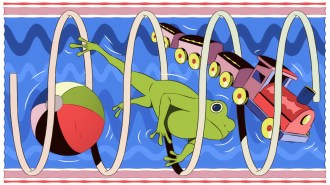- More than 2 years ago
Every true fan of science fiction (and science too, for that matter) should be familiar with Forbidden Planet, the film famous for introducing the world to Robby the Robot.
The story takes place in the 23rd century on Altair-4, where the crew of the cruiser C-57D attempts to devise a contraption to communicate with Earth. “I’ll bet any quantum mechanic in the service would give the rest of his life for a chance to fool around with this gadget,” Chief Engineer Quinn (Richard Anderson) tells Commander Adams (Leslie Nielsen).
When the film was new, in 1956, scientists would have chortled. “Quantum mechanics” weren’t repairmen for message-sending machines. It was the math for describing subatomic physics.
But it turns out that Forbidden Planet was prescient about more than just talking robots. No doubt the C-57D crew was trying to send a coded message back to Earth, made safe from eavesdropping by the use of quantum cryptography.
Born theoretically just a quarter century ago, quantum cryptography forms the foundation of a burgeoning research enterprise known as quantum information theory, which involves not just quantum communication but also the ambitious goal of quantum computation. The whole idea relies on the weirdness of quantum physics to enable messaging and computing schemes unattainable by ordinary means. Quantum communication promises to turn into technology the esoteric math with bizarre implications that Einstein famously refused to accept.
Even today, many knowledgeable physicists have a hard time coping with the rules of reality that quantum physics imposes. Most famous of those rules is Heisenberg’s uncertainty principle, which asserts the impossibility of measuring an entity’s position and velocity at the same time. (It’s an odd name, though, as nothing in nature is more certain than Heisenberg’s principle.) Flowing from that principle are other rules that read like riddles: Nature’s basic building blocks can be particles or waves, depending on how they are observed. A particle can be in two places at once, a cat can be simultaneously alive and dead, a particle can hop from one side of a wall to another without passing through it. Quantum weirdness encompasses a diverse repertoire of confusing curiosities.
Of greatest concern to Einstein, and to many yet today, is the quantum insistence that the future is not precisely determined by the past, as it allegedly was in the clockwork universe quantified by Newton. In a quantum universe, multiple outcomes are allowed, with precisely determined odds, like a cosmic horse race in which Big Brown usually wins, but not always. A radioactive atom will probably decay within a given time, but not for sure. Einstein’s desire for a deity without dice is defied repeatedly by quantum phenomena. Yet every test of the quantum rules confirms this weirdness; in any experimental challenge, quantum theory is more reliably victorious even than Tiger Woods on good knees.
Quantum physics therefore claims cosmic authority. Einstein’s theory of general relativity, for instance, is supposed to govern the cosmos on large scales, but it is widely believed to be ultimately deficient because it cannot be made compatible with quantum requirements. On the other hand, quantum physics has mostly been tested on a small scale. Quantum message sending on Earth, via light pulses transmitted through optical fibers, demonstrates that the weirdness is preserved over distances of kilometers. But that’s not necessarily enough to allay all suspicion that someday quantum physics will fail.
From space, though, quantum signals could be sent simultaneously to stations much farther than current technology allows on land. So a group of physicists has devised a plan to test the universality of quantum weirdness by following the lead of Forbidden Planet and sending quantum messages from space to Earth.
Altair-4 is too far away, of course, but the International Space Station is conveniently nearby, and the physicists are far along in plans to use it to test quantum physics. An experimental proposal called Space-QUEST, led by physicists from the University of Vienna, calls for space-to-ground signaling using the latest in quantum communication technology.
“The use of satellites allows for demonstrations of quantum communication on a global scale, a task impossible on ground with current optical fiber and photon-detector technology,” the Vienna team and their collaborators write in a new paper (online at arxiv.org/abs/0806.0945).
Some scientists wonder whether quantum weirdness will still survive at such distances. “It is an open issue whether quantum laws, originally established to describe nature at the microscopic level of atoms, are also valid in the macroscopic domain,” the physicists write.
In their proposed experiment, the weirdness in question is a particular quantum property called entanglement. It’s a consequence of quantum physics that was first fully noticed in the 1930s by Erwin Schrödinger and also by Einstein, neither of whom liked it very much. Entanglement is a sort of quasiphysical tie that binds, a link between two quantum particles that time and space cannot sever. It means that when particles of light — photons — interact and then go their separate ways, their ways are not really separate. The quantum math describing them retains an overlap, so that the fate of one depends, in a certain sense, on the fate of the other.
Without getting into the technicalities of polarization angles, you can think of entangled photons as something like pairs of spinning coins. If one turns up heads, the other will show tails, no matter how far the first is from the second, the quantum rules say. And it doesn’t matter which coin is viewed first. There’s no way to get a message from one to the other, no possible physical influence that can be transmitted to enforce this heads-tails mismatch — it just happens, instantly, as soon as one or the other photon is recorded.
It’s well within the realm of current technology to produce entangled photons, and to send them off toward separate receivers. You could (as the Vienna physicists have proposed to the European Space Agency) outfit the Space Station with a device that spits out entangled photons to stations on the ground — let’s say Fermilab outside Chicago and Caltech in Pasadena. When Fermilab physicists measure their photons, they can mark down a 1 for heads and a 0 for tails (that is, the corresponding polarization orientations) to generate a list of numbers known only to Fermilab and the senders on the Space Station. Caltech’s scientists can compile a list of numbers the same way. Each lab can then use its list of numbers as a coding key for encrypting messages with absolute security. (Any eavesdropping on the photons would have destroyed the entanglement, alerting the physicists not to use that code.)
With Caltech and Fermilab each in possession of a set of code numbers, the Space Station could send another series of numbers (even over an open channel) to both Caltech and Fermilab, and the physicists at both locations could combine those numbers with their code keys to compute another key for secure communication between those two labs.
“Using such a scheme would allow for the first demonstration of global quantum key distribution,” the physicists note in their proposal.
Global communication of quantum keys would no doubt have substantial practical applications — for secret signaling between command centers and military satellites, for instance, or for various commercial communications. The Vienna team and colleagues point out other possible uses, in synchronizing distant clocks and for research in the developing field of quantum astronomy. And space-based quantum communication would be critical to building a future quantum Internet, allowing secure communications (and perhaps computations) on a global scale.
But by far the most compelling outcome of long-distance quantum communicating would be the lesson it teaches about quantum theory’s validity. The whole scheme works only if the entanglement predicted by quantum mechanics remains valid over large scales, beyond the confines of Earth-based labs.
If so, it’s possible to imagine future space-based experiments using two stations orbiting at very different relative velocities, so that observers at each station would believe that their measurement of an entangled photon had occurred first. That would rule out any mystery signal telling the second photon whether the first was a 1 or 0. It would confirm what horrified Einstein — the reality of “spooky action at a distance.” Scarier even than Monsters from the Id.






